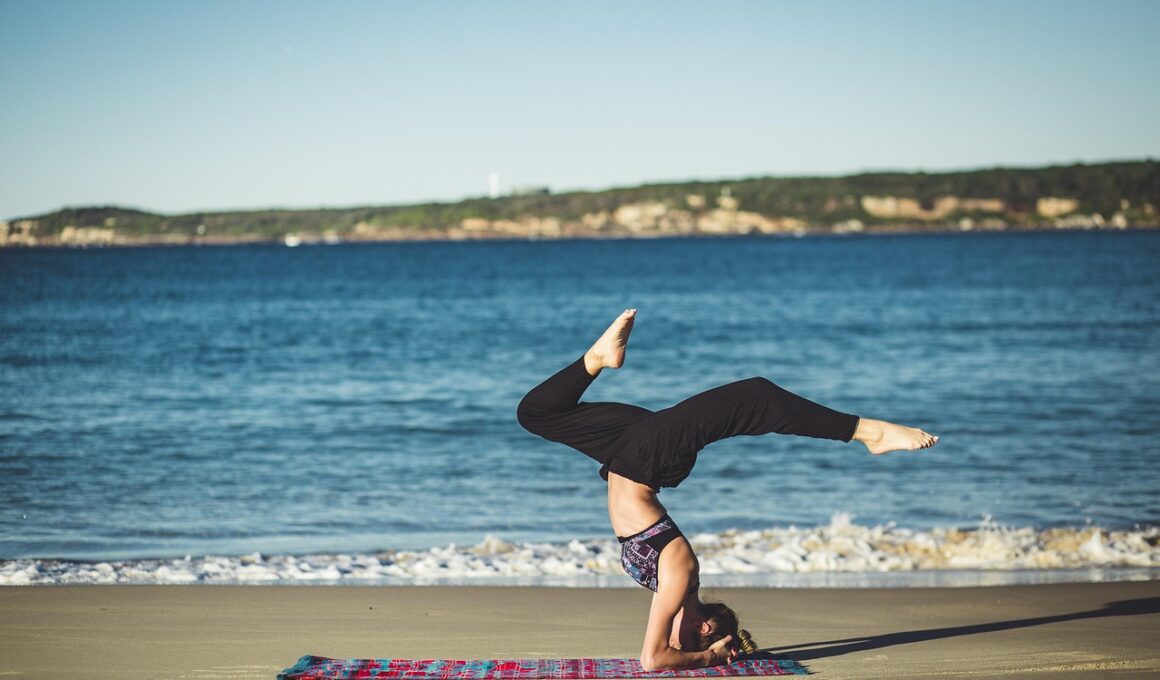Enhancing Posture with Static Balance Techniques
Static balance exercises are essential for improving and maintaining proper posture. Engaging in these exercises helps strengthen the core muscles, enhances stability, and promotes an overall sense of balance. When practiced regularly, you’ll find that standing tall becomes easier, as your body learns how to align itself correctly. Those who suffer from poor posture can benefit significantly from integrating static balance routines into their fitness regimen. By focusing on alignment during these exercises, you can create muscle memory that improves your posture throughout the day. As you gradually increase your strength in these static positions, the body will naturally adopt a more upright position when standing or sitting. This transformation will not only boost confidence but will also reduce discomfort caused by misalignment. Moreover, engaging in regular balance exercises can positively impact your flexibility and joint health. Providing additional support to your body through better posture reduces the strain on muscles and ligaments during daily activities.
The first simple static balance exercise is the one-leg stand. To perform this, simply stand on one leg while keeping the other leg bent at the knee. This exercise emphasizes concentration, as it challenges your stability and engages your core muscles. For an added challenge, try closing your eyes or holding this position for extended durations of time. Maintaining balance in this position teaches the body how to stabilize itself, further improving posture. You can also introduce variations to this exercise, such as changing the height of your lifted leg or attempting to lift the other arm. The one-leg stand can be done almost anywhere, making it an ideal exercise to incorporate into your routine. Additionally, practicing this exercise on diverse surfaces, such as grass or a yoga mat, can heighten the challenge. When done consistently, this exercise significantly contributes to muscle strength and awareness, which are both pivotal for achieving better posture. Remember to switch legs to ensure balanced strength development.
Incorporating the Wall Sit
Another static balance exercise to consider is the wall sit. This exercise involves leaning against a wall while lowering your body into a seated position. Your thighs should be parallel to the ground, and your back should remain flat against the wall. Hold this position for around thirty seconds to a minute, depending on your strength level. This exercise not only aids in balance but also engages various muscle groups, including your thighs, calves, and core, thereby improving your overall stability. Furthermore, the wall sit enhances your endurance, allowing for longer periods of maintaining proper posture during daily activities. With practice, the wall sit can lead to noticeable improvements in muscle tone and balance, allowing your body to adapt and strengthen. To make this exercise more engaging, consider timing yourself or performing it with a partner. Keeping a consistent record of your progress can motivate you to maintain balance while increasing the duration as you gain strength. Always remember to breathe deeply during this exercise to enhance concentration and relaxation.
Another effective static balance exercise is the tree pose, which originates from yoga practice and offers numerous benefits. To perform this pose, begin by balancing on one leg while placing the opposite foot on the inner thigh of the standing leg. Your hands can be positioned at heart center or extended overhead for additional challenge. This exercise strengthens the lower body while improving focus and concentration. As you hold the tree pose, it’s crucial to engage your core muscles to maintain balance throughout the duration. Additionally, by keeping your hips square and shoulders relaxed, you’ll foster better alignment and posture. As you practice this pose, try to close your eyes for an increased challenge, enhancing your balance and control. The tree pose not only promotes physical strength but also cultivates mental clarity and calmness, making it a valuable addition to any fitness routine. After holding the pose, remember to switch sides to ensure balanced development. Consistent practice will significantly improve your overall balance and posture over time.
Incorporating Static Balance in Daily Living
Static balance exercises should not only remain confined to workout sessions but can be seamlessly integrated into daily living. Consider practicing your balance posture while cooking, washing dishes, or waiting in line. Simple activities, such as brushing your teeth or folding laundry, present opportunities to practice stability on one leg or in challenging postures, which also enhance core strength. Furthermore, incorporating short, focused balance breaks during your daily routine can help to alleviate muscle tension and counteract prolonged sitting. If you’re working at a desk, try to perform a one-leg stand while taking phone calls or during break times. Engaging in static exercises throughout the day builds muscle strength and can help prevent long-term postural problems. You might also find that standing or sitting with better posture becomes more natural. Ultimately, integrating these techniques into your daily life promotes awareness of your body and helps to maintain proper alignment. Not only will this positively influence your balance, but you will also notice an improvement in overall health and wellness over time.
Another beneficial static balance technique is the plank, which strengthens multiple muscle groups, particularly the core, shoulders, and back. To perform a plank, position yourself face down, supporting your body weight equally on your forearms and toes. Keep your body straight from head to toe while maintaining your core engaged to ensure effective balance. Additionally, it’s important to avoid sagging or lifting your hips during the exercise to foster alignment and overall benefit to your posture. Holding a plank for thirty seconds to a minute can significantly enhance core strength while stabilizing the muscles supporting your spine. For added difficulty, consider incorporating variations such as side planks or planks with leg lifts. These variations challenge both strength and stability, ensuring that your muscles adapt and grow stronger over time. Planks should be part of a well-rounded fitness routine to really notice increased endurance and balance improvements. Moreover, consistently practicing this exercise will contribute positively to your daily posture, alleviating discomfort caused by poor alignment.
Final Thoughts on Balance and Posture
In conclusion, static balance exercises play a critical role in enhancing posture and daily living. By incorporating such exercises into your life, you foster stronger muscles, improved stability, and better overall body awareness. It’s essential to be patient and consistent, as improving balance and posture takes time and dedication. As you practice these static exercises regularly, you’ll likely notice significant benefits, including greater confidence, reduced discomfort, and the ability to perform daily tasks with ease. Furthermore, combining these static techniques with dynamic movements can further enhance your results, creating a comprehensive balance routine. Always be sure to consult a fitness professional when trying new techniques, as proper form is critical for safety and effectiveness. Make a conscious effort to prioritize balance exercises just as you would any other fitness commitment. With dedication and a holistic approach, you can achieve lasting improvements in your posture that significantly contribute to your quality of life. Lastly, remember to celebrate your progress, however small, as each step forward brings you closer to achieving perfect balance and posture.


